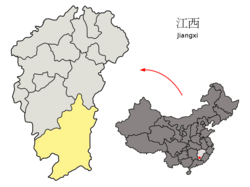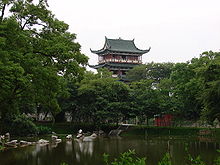Ganzhou
This section needs expansion. You can help by adding to it. (February 2009) |
Ganzhou
赣州 | |
|---|---|
| 赣州市 | |
 | |
 Location of Ganzhou within Jiangxi | |
| Country | China |
| Province | Jiangxi |
| Settled | 236AD |
| Government | |
| • Mayor | Wang Ping 王平 |
| Area | |
| • Land | 15,200 sq mi (39,400 km2) |
| Population (2009) | |
| • Total | 8,969,900 |
| • Density | 590/sq mi (228/km2) |
| Time zone | UTC+8 (China standard time) |
| Area code | 0797 |
| GDP[1] | 2009 |
| - Total | CNY 94.002 billion US$ 13.864 billion |
| - Per capita | CNY 10,479 US$ 1,546 |
| - Growth | |
| Website | http://www.ganzhou.gov.cn/ |
Ganzhou (simplified Chinese: 赣州; traditional Chinese: 贛州; pinyin: Gànzhōu) (also formerly known in English as Kanchou) is a prefecture-level city in Jiangxi province, China. Its administrative seat is at Zhanggong (章贡).
History
In 201, Emperor Gaozu of the Han Dynasty established a county in the territory of modern Ganzhou. In those early years, ethnic Han settlement and authority in the area was minimal and largely restricted to the Gan River basin. The river, a tributary of the Yangtze River via Poyang Lake, provided a route of communication from the north as well as irrigation for rice farming.
During the Sui Dynasty the county administration was promoted to prefecture status and the area called Qianzhou (虔州). During the Song Dynasty immigration from the north bolstered the local population and drove local aboriginal tribes further into the hills. Especially after the fall of the Northern Song capital of Kaifeng, migrants increased dramatically. The name was officially changed to Ganzhou in the Southern Song.
During the late 1800s Ganzhou was opened as one of the southern treaty ports and became a minor base for foreign companies. Between 1929 and 1934, Ganzhou formed a part of the Jiangxi Soviet, one of the bases of the Communist Party of China. Due to its proximity to the Red capital Ruijin (瑞金), Ganzhou was subject to a number of Kuomintang encirclement campaigns.
Administration

|
Ganzhou has jurisdiction over 1 district, 2 county-level cities and 15 counties:
District:
- Zhanggong District (章贡区)
County-level cities:
Counties:
- Gan County (赣县)
- Yudu County (于都县)
- Xingguo County (兴国县)
- Ningdu County (宁都县)
- Shicheng County (石城县)
- Huichang County (会昌县)
- Xunwu County (寻乌县)
- Anyuan County (安远县)
- Dingnan County (定南县)
- Longnan County (龙南县)
- Quannan County (全南县)
- Xinfeng County (信丰县)
- Dayu County (大余县)
- Chongyi County (崇义县)
- Shangyou County (上犹县)
Geography
Ganzhou is a large city covering the southern third of Jiangxi province, with an area of 39,400 square kilometers. It borders Hunan province to the west, Guangdong to the south, and Fujian to the east, as well as the cities of Ji'an and Fuzhou to the north. More than 70% of the area is forested. The vast majority of the province, more than 83%, is also mountainous. Several of the major tributaries of the Gan River, Ganzhou's namesake, join at a confluence in the center of the city.
Climate
Ganzhou has a humid subtropical climate (Koppen Cfa) affected by the Asian monsoon, with long, humid, very hot summers and short, mild and dry winters with occasional cold snaps. Monthly averages range from 8.2 °C (46.8 °F) in January to 29.4 °C (84.9 °F) in July. The average annual rainfall is about 1,400 mm (56 inches).
| Climate data for Ganzhou | |||||||||||||
|---|---|---|---|---|---|---|---|---|---|---|---|---|---|
| Month | Jan | Feb | Mar | Apr | May | Jun | Jul | Aug | Sep | Oct | Nov | Dec | Year |
| Mean daily maximum °C (°F) | 12.4 (54.3) |
13.9 (57.0) |
18.0 (64.4) |
24.0 (75.2) |
28.5 (83.3) |
31.3 (88.3) |
34.5 (94.1) |
34.1 (93.4) |
30.8 (87.4) |
26.1 (79.0) |
20.4 (68.7) |
15.0 (59.0) |
24.1 (75.4) |
| Mean daily minimum °C (°F) | 5.1 (41.2) |
6.9 (44.4) |
10.8 (51.4) |
16.3 (61.3) |
20.7 (69.3) |
23.7 (74.7) |
25.7 (78.3) |
25.2 (77.4) |
22.4 (72.3) |
17.4 (63.3) |
11.9 (53.4) |
6.6 (43.9) |
16.1 (61.0) |
| Average precipitation mm (inches) | 60.0 (2.36) |
103.6 (4.08) |
166.4 (6.55) |
191.6 (7.54) |
244.4 (9.62) |
204.2 (8.04) |
114.6 (4.51) |
137.1 (5.40) |
87.1 (3.43) |
65.0 (2.56) |
50.4 (1.98) |
44.8 (1.76) |
1,469.2 (57.84) |
| Average precipitation days (≥ 0.1 mm) | 12.4 | 15.1 | 18.8 | 18.0 | 18.4 | 15.5 | 12.0 | 13.2 | 9.9 | 8.2 | 7.9 | 7.7 | 157.1 |
| Average relative humidity (%) | 76 | 79 | 82 | 80 | 80 | 78 | 72 | 74 | 75 | 73 | 72 | 71 | 76 |
| Mean monthly sunshine hours | 87.8 | 73.5 | 72.3 | 100.5 | 137.8 | 173.1 | 261.0 | 235.8 | 182.1 | 165.2 | 147.1 | 142.1 | 1,778.3 |
| Source: [2] | |||||||||||||
Demographics
According to the official website[3], there are 8,456,900 people living within prefecture limits. More than 99% are Han Chinese, and 71,200 people belong to 41 minority ethnical groups (mainly She, Hui and Yao). Ganzhou also contains the largest Hakka community in Jiangxi. Almost all the people in Ganzhou speak Hakka except the urban area (Zhanggong District), which is considered as a Southwestern-Mandarin-speaking "dialect island".
Demographics
According to the official website[4], there are 8,456,900 people living within prefecture limits. More than 99% are Han Chinese, and 71,200 people belong to 41 minority ethnical groups (mainly She, Hui and Yao). Ganzhou also contains the largest Hakka community in Jiangxi. Almost all the people in Ganzhou speak Hakka except the urban area (Zhanggong District), which is considered as a Southwestern-Mandarin-speaking "dialect island".
Tourism

Ganzhou receives a small number of domestic tourists each year. Although it is encircled by mountain scenery, it is largely overshadowed by more famous attractions in Jiangxi, such as Lushan and Jingdezhen among others. Some of the places of interest in Ganzhou include:
- Mount Jiulian (九连山), Longnan County
- Mei Pass (梅关), Dayu County
- Cuiwei Peak (翠微峰), Ningdu County
- Hakka architecture (赣南客家围屋) Some of the most representative Hakka houses include Fort Xin 新围, Longnan 龙南; Fort Yanji 燕翼围, Yangcun 杨村; Fort Longguang 龙光围, Taojiang 桃江; Fort Dongsheng 东生围, Anyuan 安远 etc.
- Yugu Pavilion(郁孤台), Zhanggong District
- Bajing Pavilion(八境台), Zhanggong District
- Dongjin Bridge (东津桥): Pontoon bridges have been constructed over the Zhang and Gong rivers since the Song Dynasty. One of the bridges, the Dongjin Bridge, can still be seen. It is 400 metres long, made up of wooden planks placed on around 100 wooden boats linked together with iron chains.
The town of Zhanggong has a city wall dating to the Song Dynasty, as well as a number of pavilions and temples from the Ming and Qing. Altogether there are some 17 National Cultural Relic Protection Units in Ganzhou and 48 Provincial-level Cultural Relic Protection Units.
Transportation
Roads and highways
- China National Highways:
- Expressways of China:
Railway
The Beijing-Jiulong Railway goes through Ganzhou from north to south, and it meet the Ganzhou-Longyan Railway(Ganlong line) at East Ganzhou Railway Station in Zhanggong Distrcit.
Major railway stations in Ganzhou are:
- Ganzhou, Xingguo, Nankang, Xinfeng, Longnan and Dingnan (Beijing-Jiulong Railway)
- Gan County, Yudu, Huichang, Ruijin (Ganzhou-Longyan Railway)
Air
The new Ganzhou Huangjin Airport (赣州黄金机场), located in Nankang, was opened on March 26, 2008. Its name inherited from the old Huangjin Airport in Huangjin Town, Zhanggong District, which was closed since it was too close to the expanding Ganzhou urban area. It has domestic routes to Beijing, Shanghai, Guangzhou, Xiamen, Nanjing, Chongqing and Nanchang.
Waterway
Notable residents
Nobel Laureate Gao Xingjian (Nobel Prize for literature in 2000) was born in Ganzhou.
Sister cities
 McAllen, Texas, United States;since 1994.
McAllen, Texas, United States;since 1994. Roissy-en-France, France;since 2008.[5]
Roissy-en-France, France;since 2008.[5] Freetown, Sierra Leone;since 2008.
Freetown, Sierra Leone;since 2008. Brunswick, Georgia, United States;since 2008.
Brunswick, Georgia, United States;since 2008.
Notes
- ^ "赣州市2009年国民经济和社会发展统计公报". Ganzhou city government.
- ^ "Monthly averages for Ganzhou, China". Weather.com. The Weather Channel Interactive, Inc. Retrieved 2007-09-13.
- ^ http://www.ganzhou.gov.cn/gzgk/sqjs.aspx "Introduction of Ganzhou", People's Government of Ganzhou (Chinese)
- ^ http://www.ganzhou.gov.cn/gzgk/sqjs.aspx "Introduction of Ganzhou", People's Government of Ganzhou (Chinese)
- ^ http://www.aaecf.com/shownew.asp?id=543 "Ganzhou and Roissy become sister cities", Association Amitié Euro-Chinoise (Chinese)
